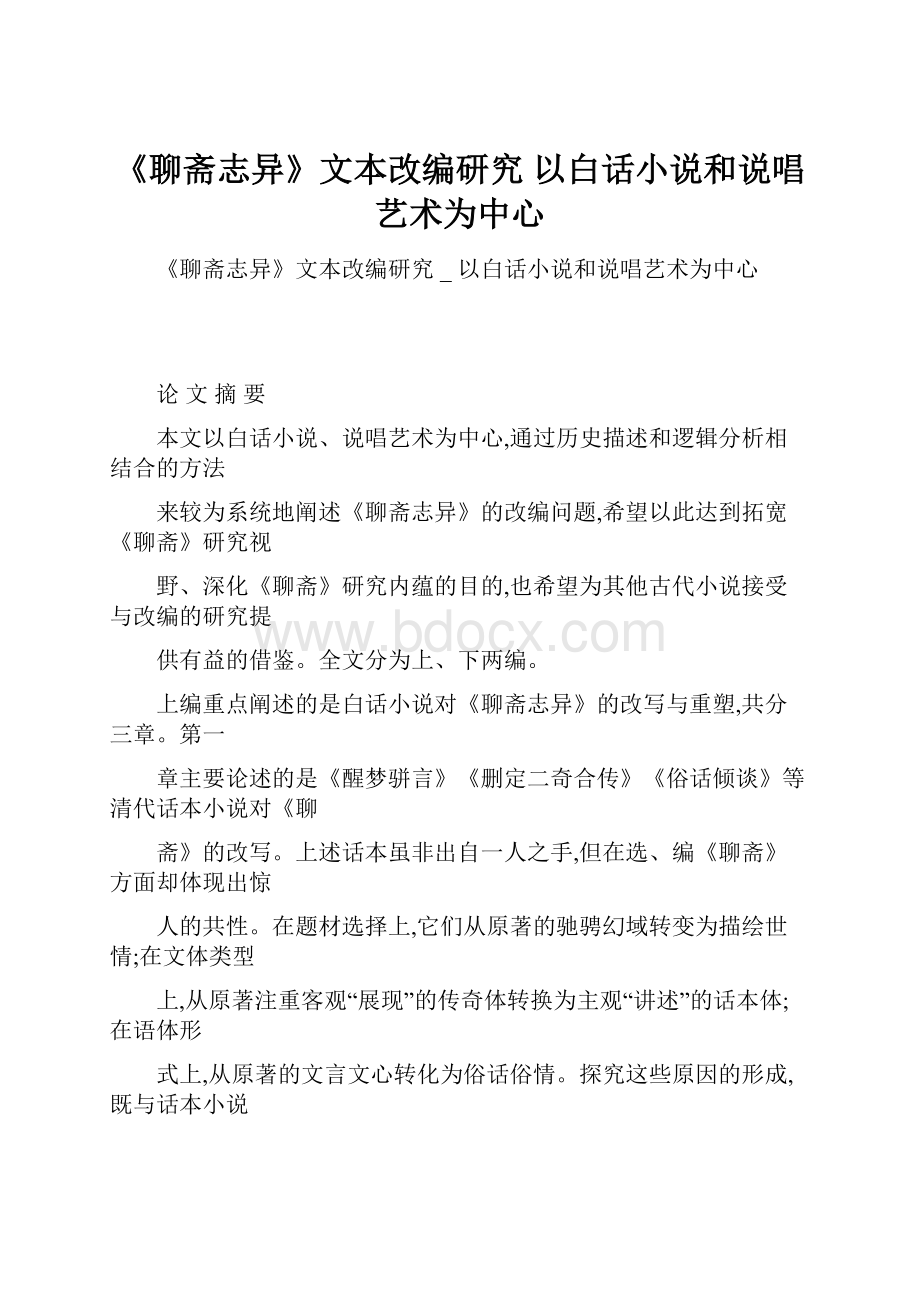《聊斋志异》文本改编研究以白话小说和说唱艺术为中心.docx
《《聊斋志异》文本改编研究以白话小说和说唱艺术为中心.docx》由会员分享,可在线阅读,更多相关《《聊斋志异》文本改编研究以白话小说和说唱艺术为中心.docx(26页珍藏版)》请在冰豆网上搜索。

《聊斋志异》文本改编研究以白话小说和说唱艺术为中心
《聊斋志异》文本改编研究_以白话小说和说唱艺术为中心
论文摘要
本文以白话小说、说唱艺术为中心,通过历史描述和逻辑分析相结合的方法
来较为系统地阐述《聊斋志异》的改编问题,希望以此达到拓宽《聊斋》研究视
野、深化《聊斋》研究内蕴的目的,也希望为其他古代小说接受与改编的研究提
供有益的借鉴。
全文分为上、下两编。
上编重点阐述的是白话小说对《聊斋志异》的改写与重塑,共分三章。
第一
章主要论述的是《醒梦骈言》《删定二奇合传》《俗话倾谈》等清代话本小说对《聊
斋》的改写。
上述话本虽非出自一人之手,但在选、编《聊斋》方面却体现出惊
人的共性。
在题材选择上,它们从原著的驰骋幻域转变为描绘世情;在文体类型
上,从原著注重客观“展现”的传奇体转换为主观“讲述”的话本体;在语体形
式上,从原著的文言文心转化为俗话俗情。
探究这些原因的形成,既与话本小说
自身的艺术规范有关,也与它们面向平民倾诉的立场有关。
“余论”则在话本对
《聊斋》改写的个案基础上扩展开来,简略探讨了话本为何热衷于改编文言小说、
话本应如何改编文言小说、话本为何早于文言小说衰亡等较为宏观的问题。
第二章主要论述的是林语堂《中国传奇》中有关《聊斋》改写的文本。
该章
主要把林语堂的改写放在中西文化交流的坐标上来进行审视,林氏选编《聊斋》
的文化基点是在于透视人性;选编的审美视界是在于彰显神秘;重编策略是在于
顺应西方的语境想像。
在行文论述中,还把林语堂的《中国传奇》和陈季同的《中
国故事》进行了比较,二人之所以在选编《聊斋》上有很大分歧,乃是由于陈是
以中国文化本位观来审视欧洲文明,而林则是从西方文化的视角来反观中国文
明。
“余论”则从直译抑或重编、异化抑或归化、中西小说交流中的入超和出超
三个方面,探讨了中国古代小说输出异域时所出现的主要问题。
第三章主要论述的是汪曾祺《聊斋新义》对《聊斋》的改写。
汪曾祺作为新
时期文坛的一个“异数”,以“打通”当代文学和传统文学为追求,他的《聊斋》
改写亦别开生面。
他将寻求现代意识作为《新义》的立意根柢,将“小改而大动”
作为重写的基本原则,在语言表达上则力求运今而涵古。
“余论”还将汪曾祺和
新生代作家进行了对比,两者虽都是重写经典文本,却体现出正仿与戏仿、重构
与解构的不同运作理路、不同文化姿态,从而构成了在现代语境中重写经典的两
种基本形态。
3下编重点阐述的是说唱艺术对《聊斋志异》的转换与熔铸,亦分三章。
第四
章论述了蒲松龄聊斋俚曲对《聊斋志异》的自我改编。
与原著文人色彩较为浓郁
有所不同,聊斋俚曲更多地彰显出的是农民的思维、农民的视野。
这是由作者晚
年创作的转型与文化视角的下移这一特定背景所决定的。
聊斋俚曲在内容上体现
出“慰藉农人”的精神和民间关怀的主旨,在艺术上表现出亦庄亦谐的喜剧风格
与大俗大白的语体特征,这都表明了作者是把俚曲创作定位于村农市媪的。
“余
论”主要围绕《聊斋志异》和聊斋俚曲的比较分析,来阐述蒲氏文学视界中大传
统(精英传统)、小传统(乡民传统)的分野与兼容。
第五章论述了子弟书、鼓词、单弦牌子曲等以唱为主的曲种对《聊斋志异》
的改编。
由于不同曲种的艺术特征和内在规范存在着一定差异,因此,它们对原
著的改编也不尽一致。
聊斋子弟书在题材选择上注重“情”之抒写,在重构故事
时多用“诗化”手法,语体表达也是雅俗共赏。
《聊斋志异鼓词》则不然,它更
关注题材“奇”之内涵,更重视“事”之翻演,语言则较为通俗。
而单弦牌子曲
在上述诸方面皆介于两者之间。
“余论”从以观众为中心的编演策略、以曲体特
征为根本的编演机制、聊斋唱曲编演的口头性与变异性等三个方面着重阐明了说
唱艺人改编《聊斋》时的突出特点。
第六章论述了以说为主的北方评书对《聊斋志异》的改编。
聊斋评书在书目
选取上既注重传奇性的故事维度,也注重题旨接受的社会性向度;在改写故事时,
聊斋评书以引人入胜的“扣子”设置与敷色添彩的细节创造取胜;并从“口头改
编”的角度,剖析了评书现场展演的高超技艺和传播效果。
“余论”则着重阐述
了聊斋评书的传播路径、《评书聊斋志异》整理本的得失等问题。
关键词:
《聊斋志异》改编白话小说说唱艺术4
Abstract
ThispapersystematicallydiscussestheadaptationofTheStrangeTalesof
Liaochaibycombininghistoricaldescriptionandlogicalanalysis,focusinguponthe
twofieldsofvernacularChinesefictionsanddramaticrecitalandsinging,inthehope
thatthestudiesoftheChineseclassicwillbebroadenedanddeepenedbythis,andthat
beneficialreferenceswillbeprovidedfortheadaptationandacceptanceofother
classicalChinesefictions.ThepaperconsistsoftwopartsThefirstpartcomprisesthreechapters,withanemphasisontheformulationof
theadaptationandremodelingofTheStrangeTalesofLiaochaibyvernacularfictionsThefirstchaptermainlydemonstratestheadaptationofthefictionbyvernacular
novelsoftheQingDynasty,suchasAParallelProseafterWakeningupfromDreams,
AnabridgedJointBiographyofTwoQis,andAHeartyTalkonFolksays.Thoughthe
above-mentionedfictionswerenotproducedbythesameauthor,theyshowed
startlingcommonnessinselectingandadaptingthecontentsofTheStrangeTalesof
Liaochai.Forinstance,inthechoiceofthethemes,theytransformedfromunrolling
theoriginalmagicfieldintothedepictionofthereality;inthestylistictype,they
shiftedfromthelegendarystyle,whichstressedtheobjective“representation”,into
thestory-tellingstyle,whichlaidemphasisonthesubjective“narration”;inthe
writingform,achangeoccurredfromtheliterarymindinclassicalChineseofthe
originalfictionintofolksaysandconventions.Aprobeintothereasonswillshowthat
theyarerelatednotonlywiththeartisticnormsofthevernacularfictionsthemselves,
butwiththeirstandofconfidingtothecommonpeople.The“FurtherDiscourses”
sectionisthedevelopmentofthecasestudyofadaptationofTheStrangeTalesof
Liaochai,whichroughlyexploressomemacroscopictopics,suchaswhyvernacular
fictionswerehighonadaptingnovelsinclassicalChineseandhow,andwhythe
formerdegeneratedearlierthanthelatter,etcThesecondchaptermainlyrelatestheadaptedversionofTheStrangeTalesof
LiaochaiinLinYutang’sFamousChineseShortStories,whichisscannedinthe
coordinatesofSino-westernculturalexchanges.TheculturalbasepointofLin’s
adaptationwasorientedtowardtheclairvoyanceofhumannature,theaesthetic
eyeshotoftheadaptationwassupposedtohighlightthemystification,andtheadopted
strategywasaimedatconfirmingtothewesterncontextualimagination.Inthis
chapter,acomparisonisalsomadebetweenLinYutang’sFamousChineseShort
StoriesandChenJitong’sLesconteschinois,thegreatdifferencesinadaptationof
whichlieinthatChensurveyedtheEuropeancivilizationfromtheChinesecultural
perspectiveandLindidthecompletelycontrarything.The“FurtherDiscourses”deals
withthemajorproblemsthataroseinthespreadingoftheclassicalChinesefictions
intoforeigncountriesinthreeaspects,namely,literaltranslationvs.new-modeling,
alienationvs.naturalization,favorablevs.unfavorablebalanceinChinese-western5exchangesofnovelsThethirdchapterismainlyconcernedwiththeadaptationofTheStrangeTalesof
LiaochaiinWangZengqi’sAnAdaptedVersionofLiaochai.Wang,labeledasbeing
“alternative”intheliterarycircleofthenewtimes,pursuedthebreakingofthe
barriersbetweenmodernliteratureandtraditionalliterature,andhisAnAdapted
VersionofLiaochaiprovedtoberefreshingandoriginal.Intheadaptedfictionhe
tookthepursuitofmodernconsciousnessasthefiction’sfundamentalconception,the
idea“Slightalterationswillcausegreatchanges”thebasicprincipleofrewriting,and
asforthelanguageemployed,themodernlanguagewiththeclassicalimplicationwas
strivedtoachieve.In“FurtherDiscourses”,acomparisonismadebetweenWang
Zengqiandthenewgenerationofwriters:
thoughthetwobothrewrotetheclassic,
theydemonstratedwidedifferencessuchasseriousorfun-makingimitation,different
operationsofrecomposingordecomposing,anddifferentculturalstands,thus
constitutingthetwobasicformsofclassic-rewritinginmoderncontextThesecondpartofthepaperisalsocomposedofthreechapterswiththe
emphasisupontheexpatiationofthetransformationsandremodelingofTheStrange
TalesofLiaochaibydramaticrecitalandsinging.Chapter4dissertatesthe
self-adaptationofTheStrangeTalesofLiaochaibyPuSongling’svulgarfolksongsDifferingfromtheformerwhichshowedmoreofliterators’features,thelatter
signifiedthethinkingandviewsofpeasants,whichwasdeterminedbythespecial
backgroundoftheauthor’stransitionsinhisoldageandhisdownwardshiftof
culturalperspectives.Thevulgarfolksongsexhibitedthespiritof“consolingthe
peasants”andtheleitmotivoffolkconcerns,andartisticallyshowedthecomedicstyle
ofcombingsobrietywithhumorandwritingfeaturesofbeingplainandcustomary,
whichindicatesthatthevulgarfolksongswereorientedtowardthepeasantsandsome
urbaninhabitantslikethosegoodies.The“FurtherDiscourses”,throughthe
comparativeanalysisofTheStrangeTalesofLiaochaiandthevulgarfolksongs,
relatesthedistinctionsandcompatibilityofthemacrotraditionselitetraditionsand
microtraditionsfolktraditionsintheliteraryvisionofPuSongling
Chapter5discussestheadaptationofTheStrangeTalesofLiaochaibysome
dramasmainlyfeaturedbysinging,suchaszidishuadramaoriginatingfromthose
childrenofManchuEight?
flagnobles,gucinorthernChina'spopularfolksongs,
accompaniedbyasmalldrum,one-stringedpaizitunehistoricallyoriginating
chieflyinthefolksongsofthesouth.Duetothedifferencesoftheabove-mentioned
dramasinartisticfeaturesandinherentnorms,theiradaptationsofTheStrangeTales
ofLiaochaidifferedfromeachother.Zidishuattachedimportancetotheexpressionof
“love”inchoosingtopics,adoptingthe“poetic”techniquesinreconstructingthe
stories,andexhibitingthewritingfeaturessuitingbothrefinedandpopulartastesGuciofTheStrangeTalesofLiaochaiwasanothercase,whichwasmoreconcerned
withthe“oddity”oftopicsandtheevolutionof“plots”,witharelativelypopular
languageusedinit.Therelevantaspectsofone-stringedpaizitunewerebetweenthe
abovetwo.The“FurtherDiscourses”illuminatedemphaticallytheobviousfeaturesof
theadaptationsofTheStrangeTalesofLiaochaibyrecitalandsingingperformersin
threeaspects,namely,theaudience-orientedwritingandperformingstrategies,the6writingandperformingmeansoftakingthedramaticstylesasbeingessential,andthe
oralityandvariabilityofthewritingandperformingofdramaticrecitalandsingingof
theLonelyStudioThesixthchapterdissertatestheadaptationofTheStrangeTalesofLiaochaiby
PingshustorytellinginnorthChina,whichfeaturesspeaking.PingshuoftheLonely
Studiostressednotonlytheselectionofthelistofromanticstories,butthesocial
acceptanceofthethemes;inrewritingstories,itattractedtheaudiencebyemploying
anenchanting“beginning”andbrilliantdetails.Thesuperbskillsandtransmission
effectsofliveperformancesofPingshuareanalyzedfromtheperspectiveoforal
adaptation.Thesectionof“FurtherDiscourses”mainlyexpoundsthetransmission
meansofPingshuoftheLonelyStudioandthegainsandlossesoftherevisedversion
ofPingshuofTheStrangeTalesofLiaochai,etc
Keywords:
TheStrangeTalesofLiaochai,adaptation,vernacularfictions,
dramaticrecitalandsinging7
前言.错误!
未定义书签。
一、《聊斋志异》接受与改编的研究概述.错误!
未定义书签。
二、选题的缘起和研究的价值..5
三、撰写的原则和研究的方法..8
上编改写与重塑:
白话小说对《聊斋志异》的改编
第一章面向平民的倾诉:
《醒梦骈言》等的改编错误!
未定义书签。
错误!
未定义书签。
第一节题材选择:
从驰骋幻域到描绘世情.错误!
未定义书签。
第二节文类置换:
从客观“展现”到主观“讲述”23
第三节语体变更:
从文言文心到俗话俗情.38
余论文与白:
文言小说与话本小说关系的若干思考..49
第二章面向西方的重编:
《中国传奇》的改编错误!
未定义书签。
第一节透视人性:
林氏选编的文化基点错误!
未定义书签。
8
第二节彰显神秘:
林氏选